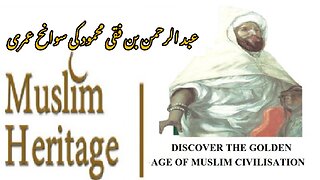Premium Only Content

Zainab bint Umar ibn al-Kindi زینب بنت عمر بن الکندی کی سوانح عمری اور ان کے مزار کی تاریخ
@islamichistory813 #zainabbintumarbinalKindi #sufisaint #cultural #heritage #biography #islamic #mysticism #islamic #philosophy #shrine #historical #figures
Biography of Zainab bint ‘Umar bin al-Kindi and the history of his shrine
Dekhti Aankhooon aur sountay kaanoon ko Asslamoalaikum, sisters, brothers friends and elders, in informative series videos of Islamic ascolars, sufisaints, cultural heritages, islamic philosophys, islamic mysticisms and historical figures. today we are describing biography of Zainab bint ‘Umar bin al-Kindi and the history of his shrine.
Zainab bint ‘Umar bin al-Kindi was a distinguished female Islamic scholar and muhaddith (hadith transmitter) who lived during the 13th century CE. She was born in Damascus, a major center of Islamic scholarship and intellectual activity in medieval Syria. Although her exact date of birth is not definitively recorded in historical sources, her scholarly activity flourished during the 13th century, culminating in her death in the year 699 Hijri, which corresponds to approximately 1300 CE. Zainab’s contributions to Islamic learning were particularly significant in the fields of hadith studies, where she emerged as one of the few prominent women to have established a strong scholarly presence in an era dominated largely by male scholars. She was respected across the Islamic world, particularly in Damascus and Baalbek, where she was active as a teacher and transmitter of sacred knowledge.
Zainab bint ‘Umar lived in a time when Damascus was a thriving hub for religious and scholarly exchange. The city had numerous mosques, madrasas (Islamic schools), and scholarly circles where the sciences of Islam, particularly hadith, were rigorously studied and transmitted. Zainab became known for her mastery of hadith and her deep understanding of Islamic jurisprudence and theology. Unlike many women of her time, she held public teaching sessions and issued ij?zahs (certificates of transmission) to male and female students alike. This alone demonstrates the high level of respect she commanded among the scholarly elite of her time. Among her most prominent students was Shams al-D?n al-Dhahab? (d. 748 H/1348 CE), one of the most important hadith scholars and historians in Islamic history. Al-Dhahabi held Zainab in high esteem, often referring to her with reverence and acknowledging her as one of his principal teachers in the transmission of hadith. Her inclusion among his list of teachers is a testament to both her scholarly authority and her recognized position within the hadith tradition.
Zainab’s role as a "shaykha" (female shaykh) or teacher was not merely nominal. In the biographical literature of the time, such as al-Dhahabi’s *Siyar A‘lam al-Nubal?’*, she is mentioned with respect and admiration. She was known for her piety, intelligence, and devotion to the pursuit of knowledge. She received and transmitted hadith from a wide range of scholars, male and female, and was known for her precise memory and trustworthy narrations. Her status as a muhaddith was established through both her scholarly lineage and her own personal credibility in the isnad (chain of transmission). In many ways, she represented the ideal of a scholar in the Sunni tradition—committed to the preservation and correct transmission of prophetic knowledge, ethically upright, and deeply embedded within a scholarly community.
Zainab bint ‘Umar died in 699 Hijri (c. 1300 CE), most likely in Damascus, where she had spent much of her life. It is believed that her funeral was attended by many scholars and students, a reflection of the deep respect she garnered throughout her life. Following her death, a shrine was built in her honor. Her shrine is located in Damascus, although specific details about the exact site vary across historical sources. It stands as a testament to her enduring legacy and the esteem in which she was held by the generations that followed her. The shrine is said to have been erected by students and admirers of her work, possibly with support from the local religious authorities of the time. While no single person is definitively credited with its construction, it is generally accepted that her followers and the scholarly community of Damascus played a crucial role in ensuring that her memory was preserved.
Today, the shrine of Zainab bint ‘Umar bin al-Kind? serves as a symbol of the important but often overlooked role that women played in Islamic scholarship. Her life and contributions continue to be remembered by historians, scholars, and students of hadith. As a woman who defied the norms of her era to become a recognized authority in one of Islam’s most rigorous sciences, she stands as an inspiration for future generations. Her relationship with al-Dhahabi further underscores her influence on Islamic historiography and the transmission of prophetic traditions. Through her teachings, she not only preserved the hadith but also helped shape the intellectual development of one of Islam’s greatest historians. Her shrine in Damascus remains a quiet but powerful reminder of the scholarly legacy of Muslim women in the Islamic tradition.
With this, we ask for your permission until tomorrow, and tomorrow we will be described biography of Zaynab bint al-Kamal and history of her shrine, at the end we pray to Allah Almighty to grant us the abilitty to act on the Quran and Hadith, Amen
Allah Hafiz
=============================
-
 7:08
7:08
ISLAMIC HISTORY
1 day agoBiography of Scholar Abd al-Rahman ibn Faqi Mahmud سوانح حیات عبدالرحمٰن بن فقی محمود
6 -

The Rubin Report
1 hour agoListen to ‘The View’ Crowd Gasp as Whoopi Doubles Down on Extremist Rhetoric
43.3K39 -
 1:16
1:16
Steven Crowder
1 hour agoI'm Back
68.1K445 -
 LIVE
LIVE
MattMorseTV
1 hour ago🔴Trump's Oval Office DECLARATION.🔴
1,814 watching -
 LIVE
LIVE
Right Side Broadcasting Network
1 hour agoLIVE: President Trump Makes an Announcement - 9/30/25
4,980 watching -
 LIVE
LIVE
LFA TV
13 hours agoBREAKING NEWS ALL DAY! | TUESDAY 9/30/25
3,728 watching -
 LIVE
LIVE
The Shannon Joy Show
1 hour agoWWE DC! Chuck The Cuck Schumer Takes On Fat Boy Trump In A Budget Battle. Live W/ David Knight
172 watching -
 LIVE
LIVE
Grant Stinchfield
30 minutes agoThe Shocking Charts That Change Everything About What you Thought About Vaccines!
84 watching -
 1:01:24
1:01:24
VINCE
3 hours agoDemocrats Can't Keep This Sex Criminal Locked Up | Episode 136 - 09/30/25
197K158 -
 1:59:05
1:59:05
Badlands Media
8 hours agoBadlands Daily: September 30, 2025
37.4K19